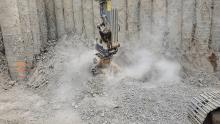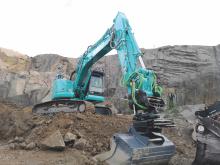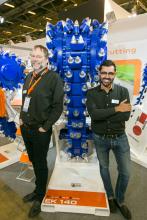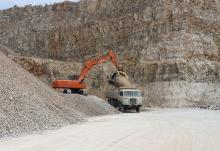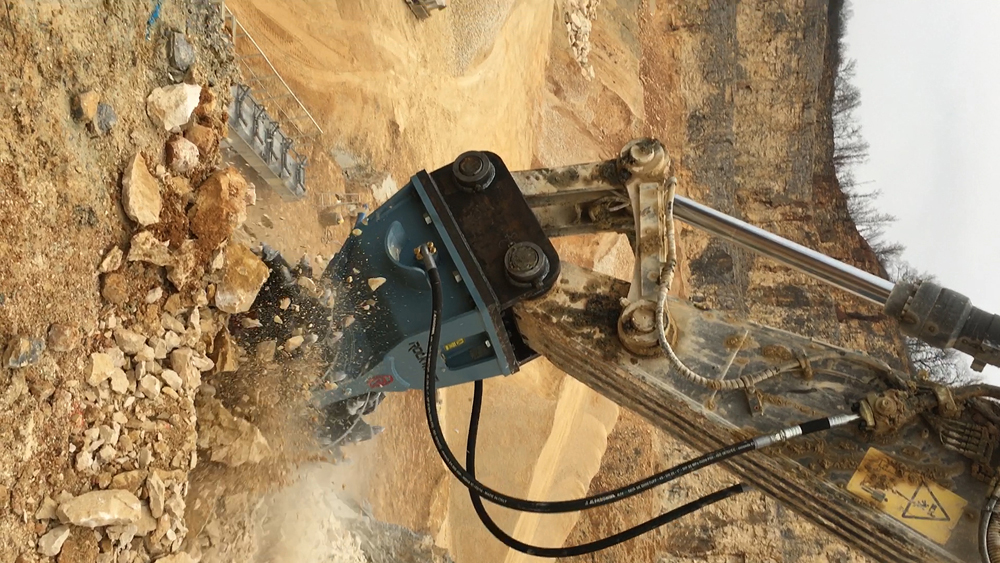
Traditionally, drill and blast, breakers and hydraulic hammers have undertaken the heavy work required in quarries and surface mines, providing a tough, productive and efficient solution. Sometimes, however, their use may be precluded due to noise, dust emissions, the location of urban dwellings or a requirement for greater accuracy. In response, many quarries have utilised hydraulic rotary cutting technology. These are commonly referred to as ‘drum cutters’, ‘cutter heads’, ‘rock grinders’ or ‘rock wheels’. These are a flexible, cost-effective and adaptable solution for rock excavation, trenching and mine/quarry wall scaling, being suitable for any application requiring materials to be cut or ground.
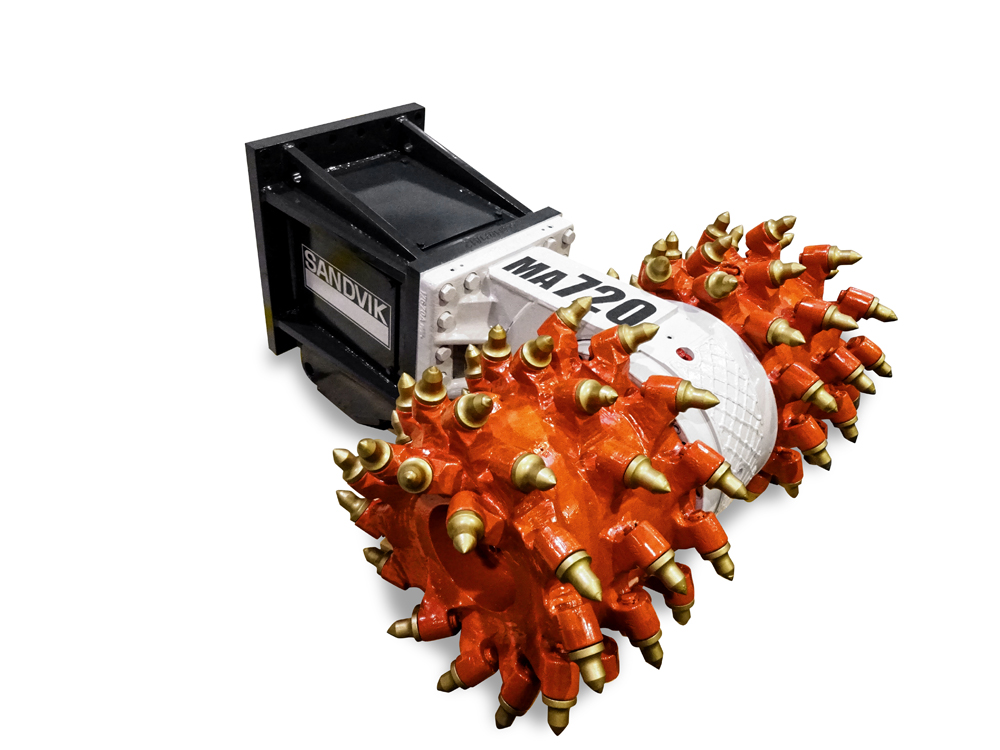
A rotary cutter head is a hydraulic attachment on which drums equipped with numerous picks spin around at rapid speed to cut rock, concrete or frozen ground. The picks that perform the cutting job are wear-resistant, have exchangeable teeth and are generally designed for efficient operations. They may also be equipped with dust-suppression systems to improve a quarry’s or mine’s environmental credentials, as well as maximising safety (in the US this has helped quarries and aggregates plants deal with the recent silica dust regulations).
The cutting heads have proved to be ideal for rock or concrete wall and surface profiling, trenching, frozen soil excavation, soil mixing, rock excavation in quarries, as well as utility work, demolition, and dredging (most appear able to work in water up to 30m in depth). Manufacturers of the equipment supply the cutters with a large variety of cutting heads for various applications, all being able to deliver precise and accurate work even in difficult conditions.
Due to both build and operating characteristics, cutting heads can be utilised in noise- and vibration- sensitive areas, as a low-vibration profile results in no or little damage to sensitive structures, thus enabling usage without inconveniencing others in the locale. This means that they are now seen as a real alternative to hydraulic breakers by generating higher productivity in quarrying due to their design and being able to provide high levels of performance and precision, especially when working in sensitive environments.
Wide cross-section of manufacturers
There is now a vast array of different cutting heads available on the market from a large cross-section of suppliers. These range from specialists in the design and manufacture of hydraulic cutting heads, whose business is entirely focused on these solutions, to multinationals with an offering that encompasses whole ranges of equipment for quarrying, mining and construction. One such latter company is Sandvik Mining and Rock Technology, which produces a range of rock cutters with fixed teeth for excavators ranging from 2.5 to 70 tonnes.
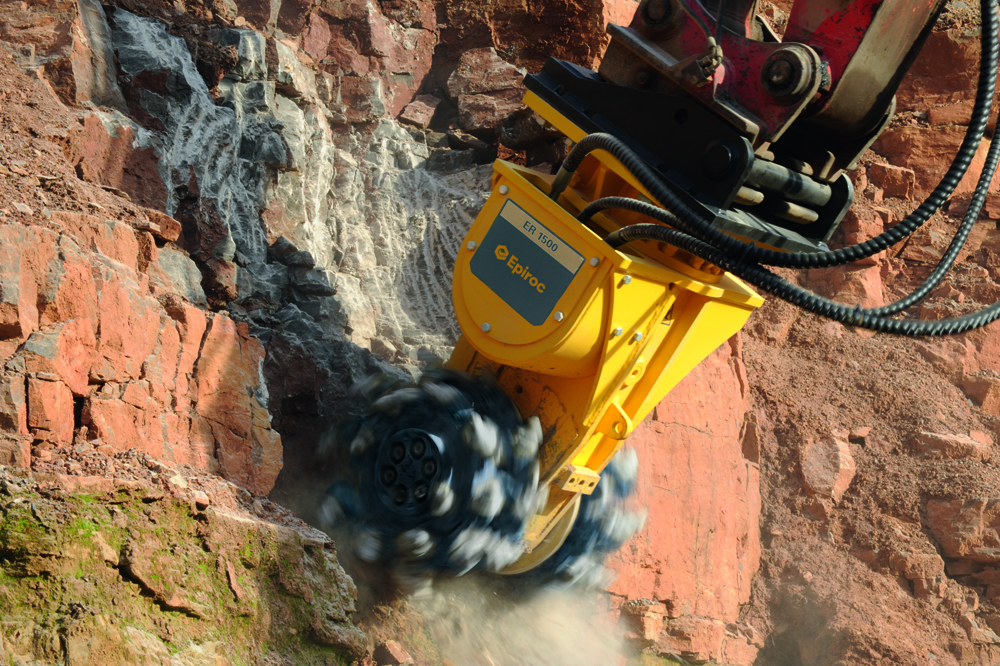
Sandvik’s RC series cutters have been designed to cut through hard rock quickly and efficiently, combine high productivity with minimal noise and vibrations, having hydraulic-powered cutting heads that can be mounted on excavators quickly and easily. They all possess efficient, geometrically-optimised cutting heads that can be used in a number of applications, including production, scaling, tunnel rehabilitation, roadway levelling, trenching and demolition. The models range from the relatively lightweight Sandvik MA520 for lighter carrier vehicles to the heavy-duty MA720. They are designed for quick change coupling between the carrier vehicle and attachment, which makes the cutting heads productive tools for any quarrying, mining or construction application. Thanks to very low maintenance requirements and minimal operating costs, they are also a highly cost-effective solution.
Another global behemoth, Epiroc, has also spotted the attributes of the cutter heads, and in order to provide a full offering acquired German company Erkat whose product line features rigid and wear-resistant gear housings to ensure a smooth cutting action, while providing maximum cutting power to penetrate the rock. The cutters have proved to be particularly adept at removing precise layers of rock or frozen ground and are fitted with a central fixing system enabling the cutter to rotate 360° without having to be disconnected from the excavator. With low vibration and quiet operation, Erkat’s cutters can also work in sensitive areas. The attachments have also been designed to help save on material costs as they don’t need to remove all of the materials, but rather just the damaged or worn surface. In some applications, the spoils from the material being cut by the cutter can be used as backfill or elsewhere on the jobsite.
A company best known for its underground equipment is US-based Antraquip, which manufactures an extensive line of hydraulic rock wheel cutters for a range of applications. Its cutters are suitable for material with uniaxial compressive strength (UCS) ranging from 500 to 25,000 pound-force per square inch (PSI) and come with such features as high torque hydraulic motors, robust, customisable cutting drums with durable spur gears and housing. Drawing on its experience of dealing with various rock types, Antraquip’s offering has been designed to suit different types and locations of rocks, as well as fitting different carrier machines.
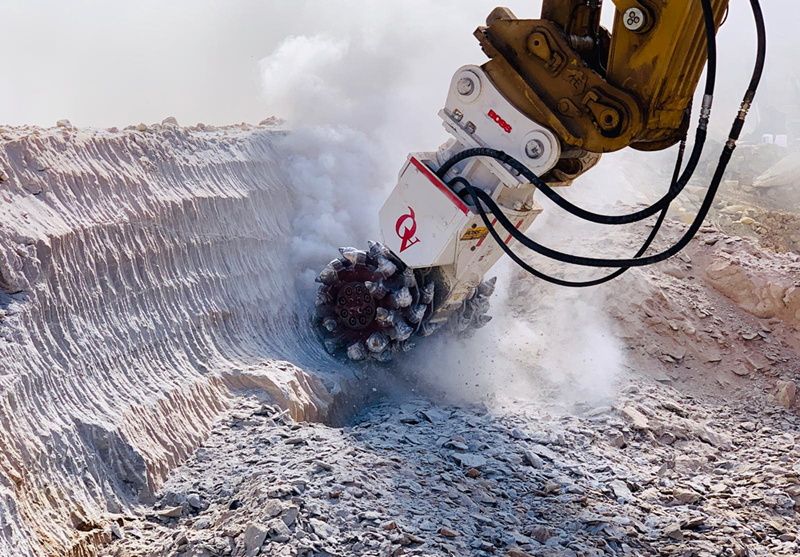
Applications of Antraquip cutters include an AQ-5 model operating at a limestone quarry in Australia, where the cutter was mounted on a CAT 374 excavator. Here, the rock being cut was a combination of medium-hard shale and hard limestone with compressive strength of up to 180MPa (26,000psi). In Colorado, an AQ-4 was fitted to a PC360 excavator operating in a quarry for production mining and quarry-roadway development work. The limestone production achieved (with average compressive strength of 10,000 psi or 70 MPa) was up to 100 tonnes per hour of net cutting.
Compact but still productive
As well as companies that are specifically associated with mining and large-scale mineral excavation and quarrying, some specialist attachment companies are also producing more compact, but still productive equipment. Two Italian companies, in particular, have drawn on their experience in producing hydraulic excavator and loader attachments. MB Crusher’s cutting heads have been designed to deal with particularly resistant and tough materials, such as fragmented rocks, although they can also deal with softer materials, such as asphalt. They have been designed to perform excavation with extreme precision. Aimed at the more compact sector of the quarrying industry, the cutters are designed to be fitted to three-12-tonne excavators as well as skid steers and backhoe loaders from three-eight tonnes. Amongst the many features of the cutters are minimal vibration and noise emissions, with a cutter body rotation that enables the operator to rotate the cutter directly from the cab.
Simex’s TF cutter heads have been purpose-developed for trenching, profiling rock and cement walls, tunnelling, quarrying, demolition, dredging, finishing operations and underwater works. They have proved to be particularly effective where conventional excavation systems are too weak, and percussion systems have little effect. Recently, the cutters were used in sedimentary rock quarries in Malta dealing with Calcarenite, which is used both as a construction material and as an aggregate. The rock has a characteristic compressive strength which ranges from approximately 20 MPa to almost 60 MPa according to the zone.
Due to the small size of Malta, many quarries are sited near urban areas or tourist attractions. This often precludes the use of drilling and blast or breakers in quarrying, which has led directly to the use of Simex cutter heads, which are capable of minimising any environmental impact but still produce cut rock to the desired sizes. The cutter head used, a TF2500, has been designed for excavators weighing 40-55t and delivers a torque of 31.7kNm and a cutting force of 83.7kN. It is also fitted with an integrated large displacement hydraulic piston motor that ensures high efficiency and high torque. Thanks to the double bearings supporting each drum on the cutter, the shaft transmits only motion and bears no load.

Kinshofer is another company that has developed its own range of hydraulic cutting attachments, recently re-badged as ‘KDC’. These are driven by high torque motors, feature modular construction and robust spur gearing with a gear reduction to increase cutting force. The attachments are also suited for underwater operation of up to 25m deep, thanks to the heavy-duty sealing system. The optional 360° rotation function allows exact positioning in corners, on quarry walls and other vertical surfaces for more accurate contouring. The optimised arrangement of picks ensures a high loosening performance and low wear. Three drum versions are available including an excavating version for cutting soft to medium-hard rock, a profiling version for shaping and levelling soft to medium-hard rock and a demolition version for cutting medium-hard to hard rocks and concrete.
Specialist manufacturers
As well as those manufacturers who produce wide arrays of associated equipment, or are hydraulic attachment specialists, two companies stand out as specialists in the field of producing hydraulic cutting heads. The design of German company Kemroc’s cutting attachments is based on many years of experience in the industry. It aims to provide maximum cutting performance with minimum wear costs, with a selection of picks and boxes and a pick pattern for enhanced rock cutting.
Kemroc has given particular attention to the design and working of the ‘picks’ on the cutting heads. When working with round picks each tool penetrates into the rock along parallel paths and breaks material out from the space between the paths. Therefore, the cutting rate depends to a large degree on the uniaxial compressive strength of the rock being cut. Other significant factors affecting production rates include the hydraulic pressure and flow that the excavator is able to supply to the attachment, as well as the stability and weight of the excavator.
The company’s DMW range has been purpose-designed for cutting hard rock with a uniaxial compressive strength of 120MPa for excavators from 14 to 60 tonnes. It is able to cut down to 1m and comes with a choice of wheels with different tooling configurations and a range of widths up to 400mm being available. The EK range of cutters is designed for use on excavators from two to 50 tonnes, being ideal for cutting stone with a uniaxial compressive strength up to 100MPa. They are efficient, vibration-free attachments for the excavation of deep, narrow trenches delivering an optimal trench profile. They are also suited to the quarrying of medium to hard minerals with compressive strength from 15 to 60MPa where drill and blast are not possible.
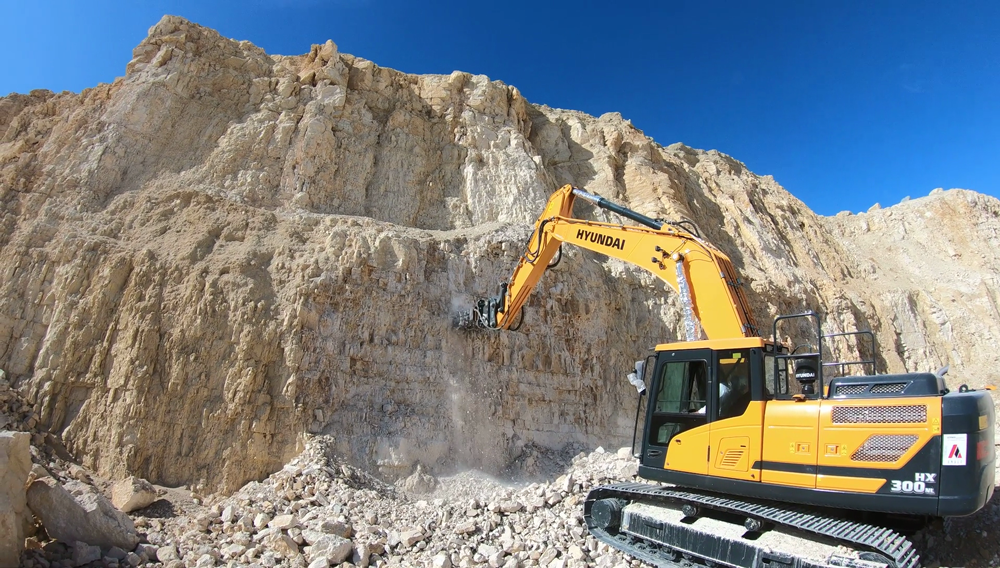
The effectiveness of the EK range is illustrated by the way in which a German company has made radical changes to the extraction and mineral processing methods at one of its gypsum quarries by using an EK 140 mounted on a 45-tonne excavator. The chain cutter replaced a hydraulic breaker as the primary extraction tool which reduced costs at the crushing plant. Changing the extraction method resulted in considerable savings in both plant and labour costs as extracting gypsum using a hydraulic breaker mounted on an excavator was proving to be generally a slow and difficult procedure for both man and machine.
When compared to the breaker, the chain cutter worked with less vibration resulting in lower maintenance requirements for the excavator. Furthermore, when a breaker was used, the material produced lay on the ground in large blocks that had to be further broken down by the breaker before the gypsum could be sent to the processing plant for crushing. Using the chain cutter made the extraction process more efficient by eliminating many of these processes, as the chain cutter enabled the excavator operator to start the production process by placing the chain cutter at the top of the wall of gypsum, then cutting its way down to the bottom. The material produced by the chain cutter also has a much smaller grain size and doesn’t require any extra work before being transported to the processing plant, thereby lowering crushing costs.
Anglo-German partnership
A rare industry development has been the pioneering ‘rock wheel’ cutting attachments, designed by a UK company but now being manufactured and marketed by a German company. Sheffield-based Webster Technologies traces its beginnings to the early 1960s, designing, manufacturing and distributing mining equipment, being one of the first companies to use hydraulics for cutting. The Webster roadheader quickly became well known in the industry and is still used in quarrying and mining applications today. Building upon its reputation as an industry pioneer, in 2013 Webster Technologies licensed the manufacture, global sales and distribution of its Rockwheel cutter to German company Rokla GmBH. This collaboration has combined creative technical design, quality manufacturing and sales and service focus.
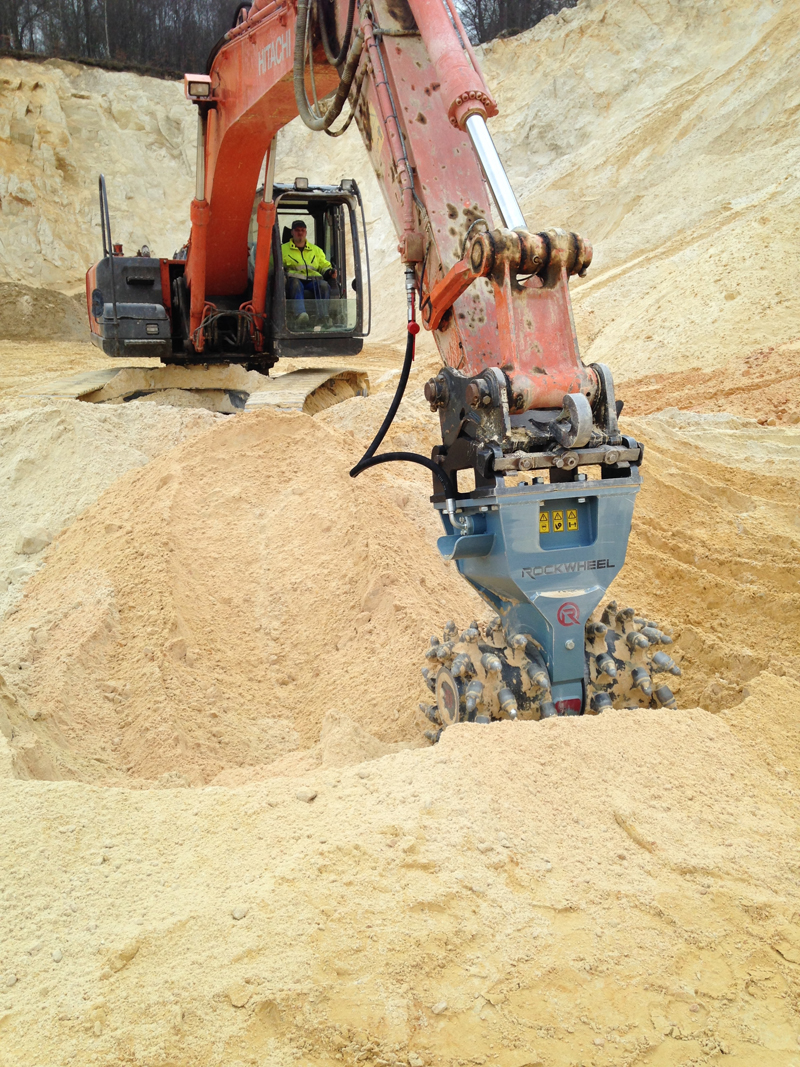 The combined rock wheel cutting technology maximises precision as well as being said to be two to three times faster than the usual speeds achieved with breakers. The extremely short cutting units, combined with their sturdy and tough housing, make quick work of removing rock. Moreover, they leave projections clearly visible and immediately workable, unlike ripper teeth which break up large pieces of rock and make work difficult for excavator operators. When the removed material is internally processed as aggregate, the Rockwheels kill two birds with one stone, as excavated material will already be one to three cm in size.
The combined rock wheel cutting technology maximises precision as well as being said to be two to three times faster than the usual speeds achieved with breakers. The extremely short cutting units, combined with their sturdy and tough housing, make quick work of removing rock. Moreover, they leave projections clearly visible and immediately workable, unlike ripper teeth which break up large pieces of rock and make work difficult for excavator operators. When the removed material is internally processed as aggregate, the Rockwheels kill two birds with one stone, as excavated material will already be one to three cm in size.
Illustrating the benefits of the Rockwheel is a particular Germany quarry which has highly abrasive rock, specifically sand and gravel. For many years scarifiers had been used for quarrying the rock (classed as a seven conglomerate,) resulting in high levels of wear and tear. The extreme impact required also placed a huge stress on the excavator being used. Having only three major components (housing, motor and cutting heads equipped with picks) meant that these difficulties were overcome by the Rockwheel D30 model, supplied with two excavating drums equipped with 60 wear-proof special picks for use in highly abrasive sand and gravel conglomerate.
All the Rockwheel cutting units possess solid drive shaft bearings and are designed for long service life. Their sealing system also enables them to operate underwater without the need for any conversion. As a rule, maintenance times are short, as all components can be easily replaced. Furthermore, when compared to the use of a breaker, the cutter produces a smaller, more consistent grain size, resulting in savings in crushing costs and material handling. The German quarry owners have been so impressed with the cutters that they are now using them at their gypsum quarries when drill and blast are not suitable for the extraction of the mineral.

